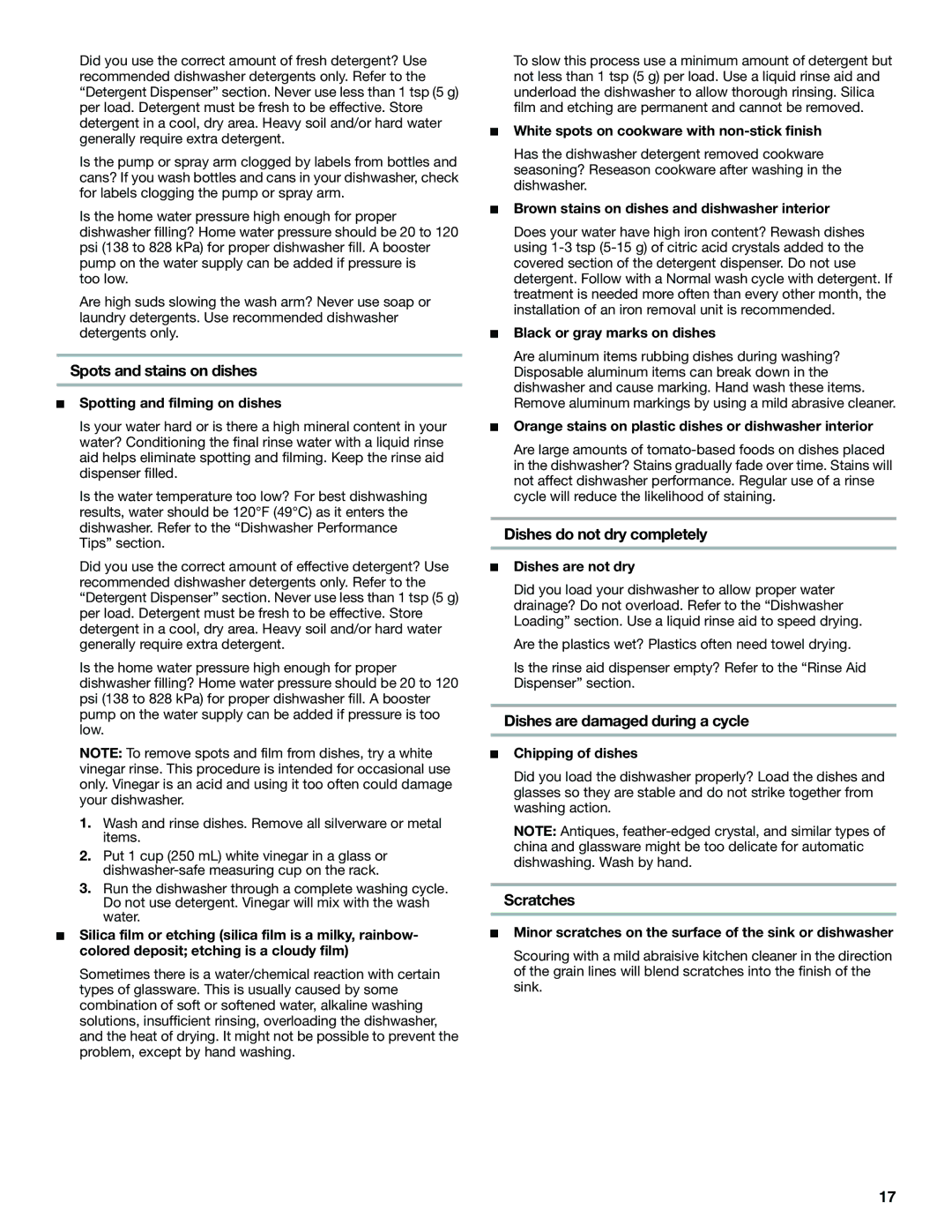Did you use the correct amount of fresh detergent? Use recommended dishwasher detergents only. Refer to the “Detergent Dispenser” section. Never use less than 1 tsp (5 g) per load. Detergent must be fresh to be effective. Store detergent in a cool, dry area. Heavy soil and/or hard water generally require extra detergent.
Is the pump or spray arm clogged by labels from bottles and cans? If you wash bottles and cans in your dishwasher, check for labels clogging the pump or spray arm.
Is the home water pressure high enough for proper dishwasher filling? Home water pressure should be 20 to 120 psi (138 to 828 kPa) for proper dishwasher fill. A booster pump on the water supply can be added if pressure is
too low.
Are high suds slowing the wash arm? Never use soap or laundry detergents. Use recommended dishwasher detergents only.
Spots and stains on dishes
■Spotting and filming on dishes
Is your water hard or is there a high mineral content in your water? Conditioning the final rinse water with a liquid rinse aid helps eliminate spotting and filming. Keep the rinse aid dispenser filled.
Is the water temperature too low? For best dishwashing results, water should be 120°F (49°C) as it enters the dishwasher. Refer to the “Dishwasher Performance Tips” section.
Did you use the correct amount of effective detergent? Use recommended dishwasher detergents only. Refer to the “Detergent Dispenser” section. Never use less than 1 tsp (5 g) per load. Detergent must be fresh to be effective. Store detergent in a cool, dry area. Heavy soil and/or hard water generally require extra detergent.
Is the home water pressure high enough for proper dishwasher filling? Home water pressure should be 20 to 120 psi (138 to 828 kPa) for proper dishwasher fill. A booster pump on the water supply can be added if pressure is too low.
NOTE: To remove spots and film from dishes, try a white vinegar rinse. This procedure is intended for occasional use only. Vinegar is an acid and using it too often could damage your dishwasher.
1.Wash and rinse dishes. Remove all silverware or metal items.
2.Put 1 cup (250 mL) white vinegar in a glass or dishwasher-safe measuring cup on the rack.
3.Run the dishwasher through a complete washing cycle. Do not use detergent. Vinegar will mix with the wash water.
■Silica film or etching (silica film is a milky, rainbow- colored deposit; etching is a cloudy film)
Sometimes there is a water/chemical reaction with certain types of glassware. This is usually caused by some combination of soft or softened water, alkaline washing solutions, insufficient rinsing, overloading the dishwasher, and the heat of drying. It might not be possible to prevent the problem, except by hand washing.
To slow this process use a minimum amount of detergent but not less than 1 tsp (5 g) per load. Use a liquid rinse aid and underload the dishwasher to allow thorough rinsing. Silica film and etching are permanent and cannot be removed.
■White spots on cookware with non-stick finish
Has the dishwasher detergent removed cookware seasoning? Reseason cookware after washing in the dishwasher.
■Brown stains on dishes and dishwasher interior
Does your water have high iron content? Rewash dishes using 1-3 tsp (5-15 g) of citric acid crystals added to the covered section of the detergent dispenser. Do not use detergent. Follow with a Normal wash cycle with detergent. If treatment is needed more often than every other month, the installation of an iron removal unit is recommended.
■Black or gray marks on dishes
Are aluminum items rubbing dishes during washing? Disposable aluminum items can break down in the dishwasher and cause marking. Hand wash these items. Remove aluminum markings by using a mild abrasive cleaner.
■Orange stains on plastic dishes or dishwasher interior
Are large amounts of tomato-based foods on dishes placed in the dishwasher? Stains gradually fade over time. Stains will not affect dishwasher performance. Regular use of a rinse cycle will reduce the likelihood of staining.
Dishes do not dry completely
■Dishes are not dry
Did you load your dishwasher to allow proper water drainage? Do not overload. Refer to the “Dishwasher Loading” section. Use a liquid rinse aid to speed drying.
Are the plastics wet? Plastics often need towel drying.
Is the rinse aid dispenser empty? Refer to the “Rinse Aid Dispenser” section.
Dishes are damaged during a cycle
■Chipping of dishes
Did you load the dishwasher properly? Load the dishes and glasses so they are stable and do not strike together from washing action.
NOTE: Antiques, feather-edged crystal, and similar types of china and glassware might be too delicate for automatic dishwashing. Wash by hand.
Scratches
■Minor scratches on the surface of the sink or dishwasher
Scouring with a mild abraisive kitchen cleaner in the direction of the grain lines will blend scratches into the finish of the sink.

